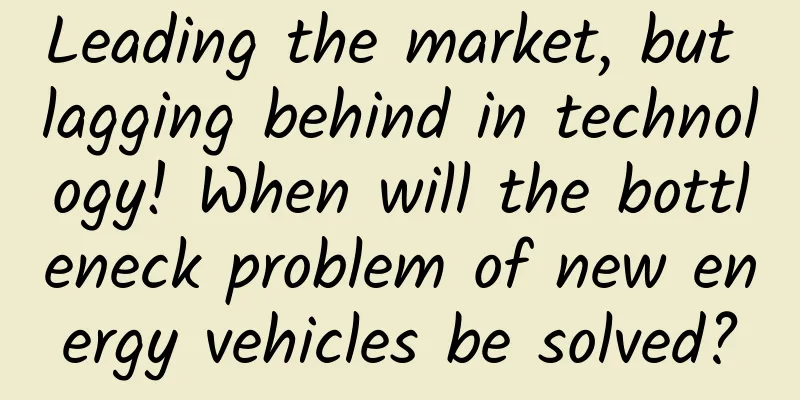Leading the market, but lagging behind in technology! When will the bottleneck problem of new energy vehicles be solved?

|
my country's new energy vehicles have developed rapidly in recent years. The annual production and sales scale of new energy vehicles and the assembly volume of lithium-ion power batteries are the world's first. New energy vehicles are expected to become a breakthrough point to catch up with the Western automobile industry. However, compared with the world's advanced technology level, some key core technologies in my country have not yet been mastered. This is believed by many people in the industry to become a constraint on the high-quality development of my country's new energy vehicles. The "2018 Global Electric Vehicle Development Index" recently released by Roland Berger shows that at the market level, China ranks first, but at the technical level, China is far behind Japan, France, the United States and other countries, ranking only sixth. At the 2018 China Automotive Industry Development (TEDA) International Forum held in early September, Xu Chaoqian, deputy director of the High-tech Development and Industrialization Department of the Ministry of Science and Technology, pointed out that although the development of my country's new energy vehicle industry has achieved certain results through multi-departmental and cross-industry cooperation and linkage, its development still faces many severe challenges. The next research focus of new energy vehicles can be summarized in nine words, namely, to make up for shortcomings, build advantages, and strengthen capabilities. Among them, to make up for shortcomings is to find the existing deficiencies in strategic products. The government will focus on the technical shortcomings of strategic products involving national security, economic security, and industrial security. So, what are the technical shortcomings in the development of new energy vehicles in my country? How do these technical shortcomings affect the development of new energy vehicles in my country? In this regard, Sun Fengchun, an academician of the Chinese Academy of Engineering and a professor at Beijing Institute of Technology, told reporters that in the development of new energy vehicles, there are some "bottleneck" technologies in key technologies such as "big three electrics" (motor, battery, and electronic control), "small three electrics" (electric braking, electric steering, and electric air conditioning), lightweight, and all-weather stability. These technologies need to be overcome urgently, otherwise they will restrict the subsequent high-quality development of my country's new energy vehicles and weaken my country's currently accumulated advantages in the development of new energy vehicles. Core materials for power batteries are heavily dependent on imports Wang Binggang, leader of the expert group of the National New Energy Vehicle Innovation Project, told the China Automotive News that in the development of new energy vehicles, the first driving force battery has faced the greatest challenges. At present, my country's power battery industry is developing rapidly, with large production and sales, and there are also some excellent power battery companies. However, at present, some materials for high-quality power batteries in my country still rely on imports, and some core equipment for power battery manufacturing also needs to be imported. These are difficulties that need to be overcome. In addition, Japanese and Korean power battery companies are strong, but in recent years, due to various reasons, they have not been able to enter the Chinese market smoothly. With the acceleration of the pace of opening up, these companies will accelerate their layout in China, which will also bring certain challenges to domestic battery companies. Regarding my country's power batteries, the industry has clear development goals, namely high energy, high energy efficiency, high safety, long life, all-weather, all-solid-state, and low cost. "All-solid-state batteries and battery management systems are two core technologies. The technical goals of my country's 13th Five-Year Plan for electric vehicles are battery cell density ≥300Wh/kg, life ≥1500 times, cost ≤0.8 yuan/Wh; battery system energy density ≥210Wh/kg, life ≥1200 times, cost ≤1.2 yuan/Wh." Sun Fengchun said that we can achieve such expected goals. But he also emphasized that my country needs to make breakthroughs in battery positive and negative electrode materials, diaphragms, electrolytes, manufacturing processes, high-end manufacturing equipment, etc., especially diaphragms and high-end manufacturing equipment still need to be imported, which are "stuck neck" technologies for power batteries. "From an industry perspective, the United States has relatively strong R&D and design capabilities, and is still leading the original innovation of lithium batteries and the R&D of core materials. Japan, as a major battery material manufacturing country, has strict production standards and can be the first to produce new finished batteries. my country and South Korea are in the second echelon." Zhou Zhen, director of the Institute of New Energy Materials Chemistry at Nankai University, once pointed out that in my country, among the four core materials of high-end batteries, the diaphragm industry is still a shortcoming and is still heavily dependent on imports. "The lack of core technology and the lack of key materials such as diaphragms have become an unbearable pain for domestic lithium batteries," said Zhou Zhen. Lack of high-speed, high-efficiency and high-power motors In the development of new energy vehicles, in addition to power batteries, the technological development and upgrading of motors and electronic controls, which are components of the "big three electrics", cannot be ignored. Data shows that in 2017, my country's drive motor production capacity exceeded 2.2 million units, and some companies have entered the international vehicle supporting system. At present, my country has companies such as BYD, Shanghai Electric Drive, and Jingjin Electric that provide high-power drive motors and motor controllers, as well as companies such as Shandong Deyang, Hangzhou Jieneng, and Yongkang Scorno that provide low-power drive motors and controllers. Relevant experts from the China Society of Automotive Engineers believe that in the field of pure electric vehicles, my country's independent research and development of motors and electronic control systems has been relatively good, and some companies are also providing R&D prototypes or batch matching for multinational companies. But even so, there is still a certain gap with the advanced level of foreign countries. According to statistics, in the past 10 years, the total number of patent applications for new energy vehicle motors and drive control systems in my country ranked first in the world, but the invention patents that best reflect the technical level only accounted for 50%, while the total number of foreign invention patent applications in the same period accounted for 90%. In addition, foreign brands have also set their sights on the Chinese market. Currently, Toyota, Honda and other vehicle manufacturers have set up automotive motor factories in China to supply their own industrial chains; Bosch, ZF and other auto parts companies have established joint ventures with domestic companies to develop and produce new energy vehicle drive motors; independent motor suppliers such as Remy Motor have also set up factories in China. Faced with "strong enemies", my country's motor industry, which is technologically weak, will also face many challenges. In this regard, Sun Fengchun said that my country still has many shortcomings in motor research and development. High-speed, high-power density, high-power motors, high-power, high-speed bearings, etc. are all short-board technologies, and some key components and high-speed bearings are still imported. "If we want to reduce the energy consumption of electric vehicles, we must make the motors of electric vehicles work in the high-efficiency area, and continue to tackle key problems and work hard in core key basic components such as high-speed, high-power density motors, electronic chips, third-generation semiconductor high-end computing chips, and high-speed bearings. At the same time, electric wheel hubs will also become the next focus of technological research and development and breakthroughs." Sun Fengchun said. In addition, Sun Fengchun also told reporters that in the research and development of electronic control systems, large-scale computer software and simulation technology, operating systems, etc. are also areas that my country lacks, and these technologies are almost zero. The shortcomings of the "three small electrics" have greatly reduced the performance of electric vehicles The replacement of fuel vehicles by electric vehicles not only means that the power system will be changed from traditional internal combustion engines to electric drive, but also that all vehicles will be electrified. Wang Binggang said that in addition to the "big three electrics", electric vehicles also need efficient electric braking, electric steering and electric air conditioning systems, and the research and development of the so-called "small three electrics" technologies needs to be paid attention to. For example, the braking energy recovery part of the electric braking system is closely related to safety, handling stability and energy consumption level. At present, domestic enterprises have conducted research in these areas, but the results are not ideal and have not yet reached the international advanced level. Sun Fengchun told reporters that the current calibrated driving range of electric vehicles does not include air conditioning, but in actual use, once the air conditioning is turned on, the driving range will drop a lot. Air conditioning consumes too much energy, and many users dare not use it, which affects the driving comfort of electric vehicles. According to him, air conditioning cooling and heating will reduce the driving range by one third or even more. "The next goal is to have efficient cooling and heating air conditioning, and the research and development goal is to reduce energy consumption by 30% to 45% compared with existing products." Sun Fengchun said. Wang Binggang also emphasized that electric air conditioning is a short board technology in the development of electric vehicles. At present, domestic companies have been developing efficient and low-energy air conditioners, but there are no better products yet, and the industry needs to pay more attention. In addition to the "big three electrics" and "small three electrics", technical shortcomings such as lightweight and all-weather stability of electric vehicles are also hot topics of concern in the industry. Relevant research shows that for every 10% reduction in the weight of an electric vehicle, the driving range will increase by 6%. "Weight reduction" of electric vehicles can effectively reduce energy consumption. It is understood that there are currently three main technical development directions for lightweight electric vehicles: material lightweighting, structural lightweighting, and connection lightweighting. Sun Fengchun believes that the importance of structural lightweighting is far greater than material lightweighting. The structural changes of electric vehicles plus the lightweighting of materials and connections, combined with new processes for automobile production, can achieve lightweighting beyond expectations. This should become the main direction of industry research. In addition, it is well known that electric vehicles are "afraid of cold". At present, the northeast, northwest and high-altitude cold regions are almost "forbidden zones" for electric vehicles. "Batteries are problematic to start and operate in cold regions. In a -25℃ environment, the driving range of electric vehicles will drop by less than half, or even more." Sun Fengchun said that my country must develop all-weather vehicles and batteries that can operate in all weather conditions in the next step. The all-weather operation he mentioned means that electric vehicles can operate normally at -40℃. It is also necessary to increase support for the parts industry Wang Binggang believes that compared with traditional cars, my country has obvious advantages in the field of electric vehicles, and has developed well in batteries, motors and electronic controls, but there are also many shortcomings. If these technologies are not taken seriously, they will hinder the high-quality development of my country's new energy vehicles. He emphasized that the key technologies that currently hinder the subsequent development of electric vehicles are related to the weak overall technical foundation of the automotive industry. Compared with traditional automotive technology, electric vehicles have some overlaps with it, but they also have their own unique technologies. At present, these technologies still have problems such as poor processing accuracy and poor raw material development level compared with the world's advanced level. "This is not just a problem with electric vehicles themselves. In fact, the gap in the industrial base is reflected in the car." Wang Binggang said. According to a recent report by China News Network, the Ministry of Industry and Information Technology's survey of more than 130 key basic materials in more than 30 large enterprises across the country showed that 32% of key materials are still blank in China, and 52% rely on imports. In the field of equipment manufacturing, more than 95% of the manufacturing and testing equipment on the finishing production lines of key parts such as high-end CNC machine tools, high-end equipment and instruments, launch vehicles, large aircraft, aircraft engines, and automobiles rely on imports. Based on this, Wang Binggang emphasized: "my country must truly strengthen support for the basic parts industry. The focus of national support cannot be placed only on complete vehicles. Many core technologies are in parts." As a winner of Toutiao's Qingyun Plan and Baijiahao's Bai+ Plan, the 2019 Baidu Digital Author of the Year, the Baijiahao's Most Popular Author in the Technology Field, the 2019 Sogou Technology and Culture Author, and the 2021 Baijiahao Quarterly Influential Creator, he has won many awards, including the 2013 Sohu Best Industry Media Person, the 2015 China New Media Entrepreneurship Competition Beijing Third Place, the 2015 Guangmang Experience Award, the 2015 China New Media Entrepreneurship Competition Finals Third Place, and the 2018 Baidu Dynamic Annual Powerful Celebrity. |
<<: Baoneng emerges as buyer of Pangda in crisis
Recommend
APP user growth: How to use data analysis to improve user growth?
How can we make our APP stand out among a large n...
Mango TV starts Kung Fu mode: "But we are not all-powerful heroes"
The number of users has exceeded 10 million, the ...
Pre-prepared meals are becoming more and more popular. Is it unhealthy to eat them frequently?
Have you heard of pre-prepared meals? There is a ...
Yuppie Emotions·Laosan Love Study "Dating Course"
Quick love, emotional manipulation, freezing and ...
Is it scientific to walk a hundred steps after a meal and live to 99?
In today's fast-paced life, being able to put...
Commercialization and monetization guide: How to improve the eCPM of information flow advertising?
Information flow advertising is almost a must for...
How to convert the raw and cooked weights of food? The weights of food recommended by the New Dietary Pagoda are all raw weights.
On April 26, the long-awaited 2022 edition of the...
Why can’t my Baidu bidding idea pass the review?
Bidding promotion work is rather boring, but also...
Tesla fatal crash investigation finds Autopilot not at fault
According to foreign media reports recently, the ...
Why are many non-social apps so keen on social + content?
It is easy to create an APP, with a R&D team ...
Three unfavorable factors: Where is Samsung's chance to redeem itself?
Samsung, whose founder is in poor health, may hav...
How will the medical bidding situation change after 360 returns to the medical field?
Starting from June 17, 2017, Baidu Fengchao promo...
Android 14 system causes trouble, Google Pixel 6 phone storage space cannot be accessed after upgrade
On October 18, every time Android releases a new ...
The Rainbow UAV, the "King of the Clouds"! The Rainbow-6 made its debut at the Zhuhai Air Show. What surprises will it bring?
The large-scale international air show held in Zh...
Excessive marketing of Hisense TV may be the main reason for the decline in net profit
2017 was undoubtedly a difficult year for color T...









